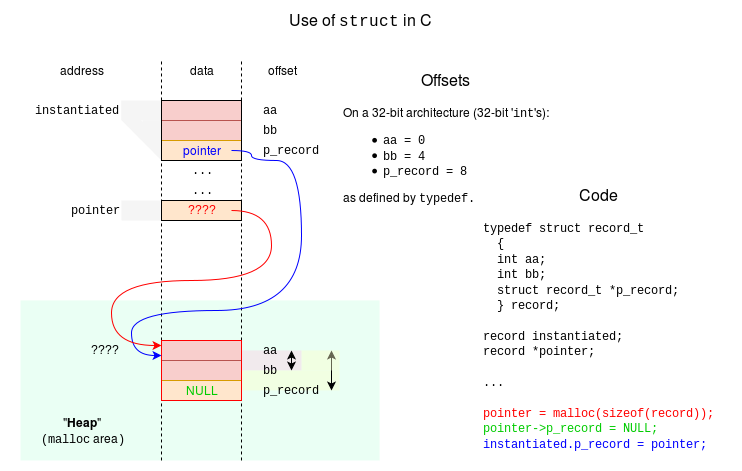Structures
| On path: Pointers | 1: Memory • 2: Arrays • 3: Pointers • 4: Pointer Exercise • 5: Structures • 6: Dynamic Memory Allocation • 7: Malloc Exercise • 8: Structs Exercise |
|---|
| Depends on | Memory |
|---|
Traditionally called a record these are probably known mostly to programmers by the C term struct. They are basically like the data parts of an object in Java et alia.
The examples below use C syntax, which is a bit obscure: hopefully the figure will help to clarify what the syntax means!

In the code, declarations are in black:
typedefdefines a structure (like a ‘class’) which has some offsets.- Two variables are declared:
instantiated, which is arecordpointerwhich is a pointer.
The dynamically executed statements are in colours:
- a new record is created and its address stored in
pointer; this address of this record was not known to the compiler. - the field p_record of the new record is set to
NULL.->is used becausepointeris not the record, it is a pointer to it.
- the field p_record of the
instantiatedrecord copied frompointer..is used becauseinstantiatedis the record in question.
If that’s confusing – it probably is, first time (and second time) through – just go through it slowly. The syntax is not nice, but it does make logical sense. (Eventually.)
Test
If you’re feeling brave, try these:
- What value is at
instantiated.p_record->p_record?
The value is NULL.
instantiated.p_record is a pointer; its value points to the (lower) structure.
->p_record addresses the p_record field at that pointer.
The contents of that field is a NULL.
- What would happen if the next statement was the one below?
pointer->p_record = &instantiated;
The NULL would be overwritten to point back at the original (upper) structure.
This would be a slightly odd thing to do, as it links the two records in a circular chain although it has not caused a memory leak as we can still find the dynamically allocated structure. (If we look hard enough!)
- How could you assign
pointerto point to the statically instantiated record?
pointer = &instantiated;
pointer (contents) becomes the address instantiated.
Still baffled?
Try this analogy: a structure is like an array but:
- the elements can be different sizes
- the indices have fixed names rather than being numbers
- the syntax looks different
Thus, for a system which (for example) has 32-bit integers and 64-bit pointers:
typedef struct example_type_1
{
int first; // 4 bytes
int second; // 4 bytes
int *third; // 8 bytes (pointer)
int fourth; // 4 bytes
} example;
would (probably) set the following (byte, decimal) offsets:
| field | offset |
|---|---|
| first | 0 |
| second | 4 |
| third | 8 |
| fourth | 16 |
Although this is really up to the compiler and it could choose differently. There is no real need for you to know.
Thus:
example_1.fourth = 1234;
is sort of like:
example_1[16] = 1234;
(except the ‘array index’ has been scaled already to the byte address).
Even a bit more detail!
On the other hand, a naive compiler might leave spaces in the record to align the longer fields. A ‘cleverer’ compiler might pick a reorder from the source code for compactness. See the figure below, showing memory 64-bits wide, for details.
typedef struct example_type_2
{
int alpha; // 4 bytes
int *beta; // 8 bytes (pointer)
int gamma; // 4 bytes
int *delta; // 8 bytes (pointer)
} example;
would (probably) set the following (byte, decimal) offsets:
| field | (naive) offset | (clever) offset |
|---|---|---|
| alpha | 0 | 0 |
| beta | 8 | 8 |
| gamma | 16 | 4 |
| delta | 24 | 16 |

Alignment onto word boundaries – we have a 64-bit machine here – will make memory access more efficient (but this is moving into hardware architecture).